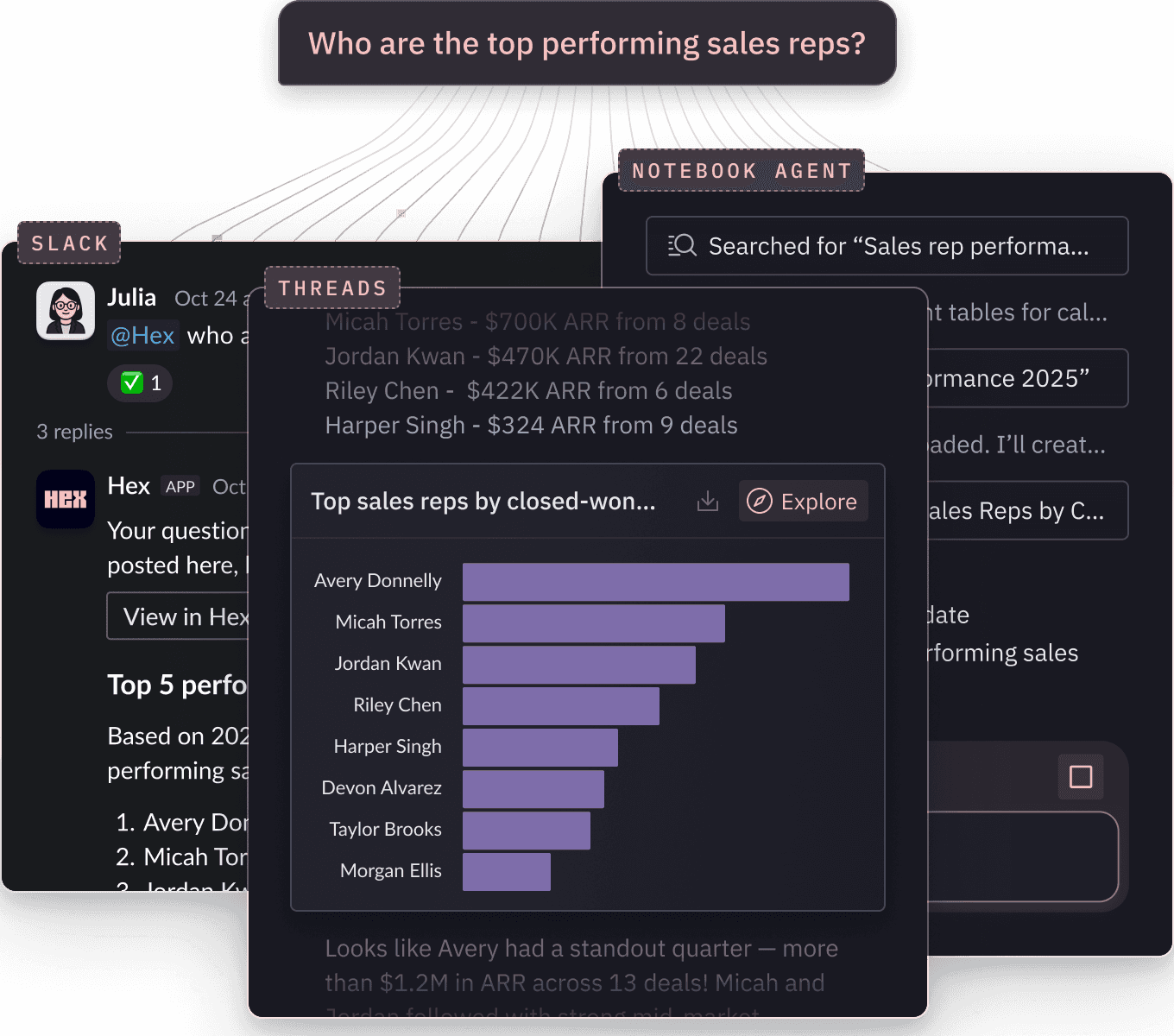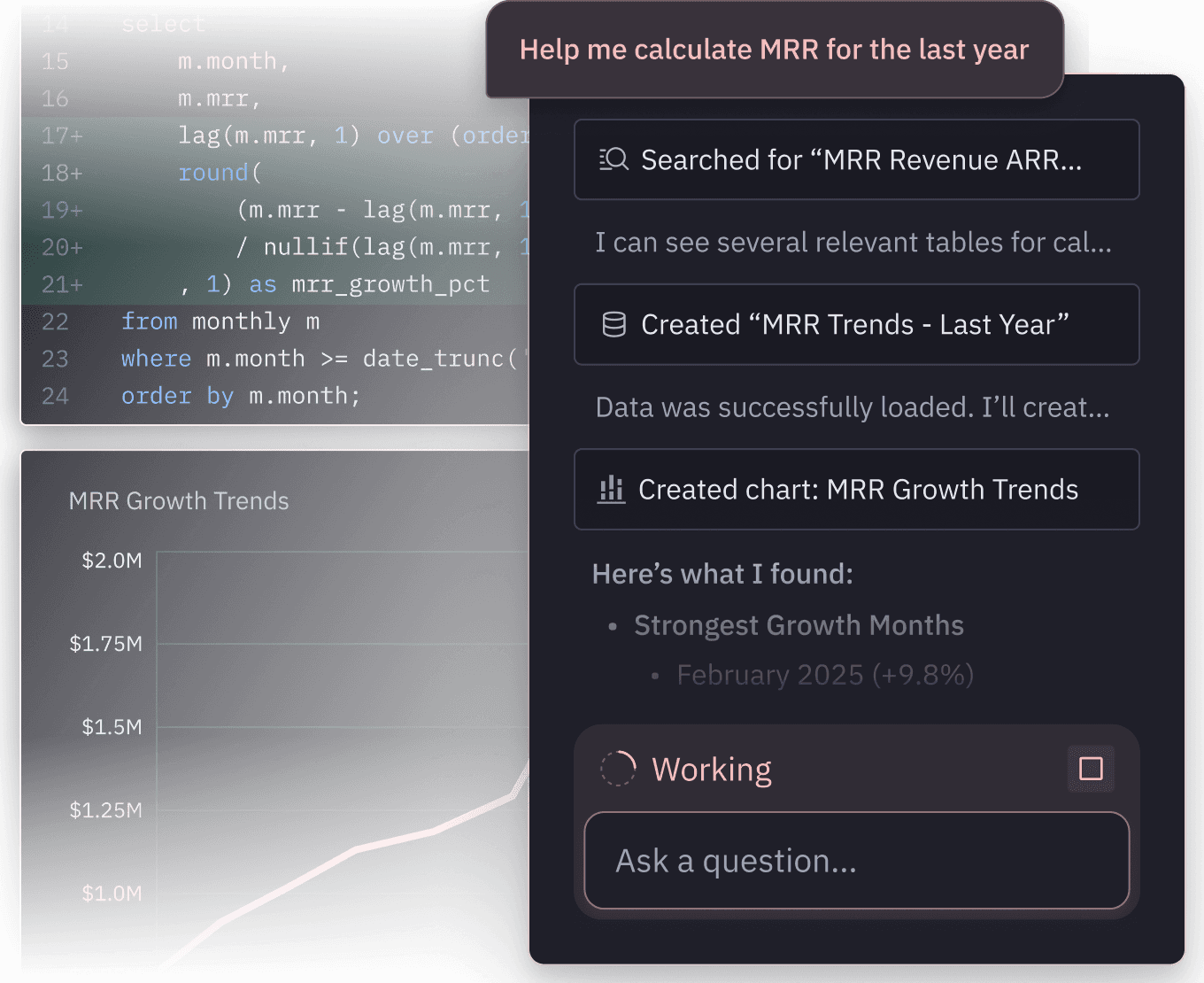Comparing Hex vs. Omni
Choosing between Hex and Omni? Modern data teams choose Hex to power faster, deeper insights with AI.
Trusted by leading data companies
"Our vision for Notion’s data team is that anyone, regardless of technical proficiency, is comfortable using data to answer their own questions – and Hex enables that."
Abhishek Modi, Software Engineer"We like to embed Hex dashboards where teams work."
Ian Macomber, Head of Data and Analytics Engineering"We’re regarded as top performers because the work we are doing is deemed more credible and more widely surfaced than before Hex."
Kate Urquiola, Director, Go-to-Market Analytics"Hex has helped us empower business analysts to explore and dig into data on their own"
Meghana Reddy, Head of Data at Stubhub
Why companies choose Hex over Omni
Power agentic capabilities for every workflow
Hex's Notebook agent helps data teams build analyses, while Threads lets business users ask questions, get detailed answers, and iterate through follow-ups.
In Omni, AI is constrained to surface-level questions and one-shot answers. Fine for what happened, but limited for iteration or deeper analysis.

Comparison breakdown
Features
Hex
Omni
AI for analysis
Code generation, debugging, and multi-step reasoning
Hex
Notebook Agent assists with writing and refining SQL, Python, and charts; reasons through multi-step logic and debugging.
Omni
No AI support for code generation, debugging, or building analyses.
AI for business users
Natural language querying with context retention
Hex
Threads enables multi-turn reasoning and context retention across live data conversations.
Omni
Chat-based exploration allows for single-shot questions; Limited for multi-step reasoning.
AI for modeling
Build semantic resources using natural language
Hex
Modeling agent builds and updates semantic models from natural language.
Omni
No AI assistance for model authoring; modeling is fully manual.
Build interactive data apps, not just dashboards
Hex makes complex analyses, like forecasts and what-if scenarios, shareable as live, interactive data apps, so end stakeholders can interact with data and explore data insights.
Like most BI tools, Omni centers work around static dashboards. Good for KPIs, but limited for scaling deeper analysis or interactivity.

Comparison breakdown
Features
Hex
Omni
Interactive apps
Dynamic exploration beyond dashboards
Hex
Data apps include inputs and controls, like dropdowns, sliders, and date pickers, for truly interactive analysis.
Omni
Dashboards are static, with limited filtering and no interactivity.
Live analytical logic
Computation and modeling built in
Hex
Data apps run live Python and SQL logic, enabling forecasting, what-if scenarios, and other advanced analyses directly in the app.
Omni
Dashboards show static results with no computation or modeling.
Reporting dashboards
Standard KPI and metric tracking
Hex
Create dashboards and visualizations using no-code charts or Python libraries.
Omni
Create dashboards with customizable Vega-Lite charts.
Go beyond the boundaries of the model
Hex gives analysts freedom to explore, combining SQL, Python, and no-code in Agentic notebooks to prototype, test, and promote ideas back into governed models.
Similar to Looker, Omni locks analysis inside a proprietary modeling layer, limiting exploration to predefined data.

Comparison breakdown
Features
Hex
Omni
Semantic model interoperability
Work with models from any source
Hex
Turnkey integration with Snowflake Semantic Views, dbt Metric Flow, and Cube—connect, sync, and explore instantly.
Omni
Only offers sync with Snowflake Semantic Views.
Ad hoc exploration
Flexible, multi-language analysis
Hex
Mix SQL, Python, and no-code interchangeably for rapid, frontier analytics.
Omni
Limited to SQL against pre-modeled data.
AI model authoring
AI-assisted modeling with project context
Hex
Reference projects for the Modeling agent to bootstrap new semantic models.
Omni
Models must be written and maintained manually.
Unify the full cycle of data work with Hex.
Leave disconnected workflows behind.
Hear from data teams that chose Hex
Learn how the best companies in the world increase team efficiency using Hex.
FAQ
Can't find your answer here? Get in touch.




